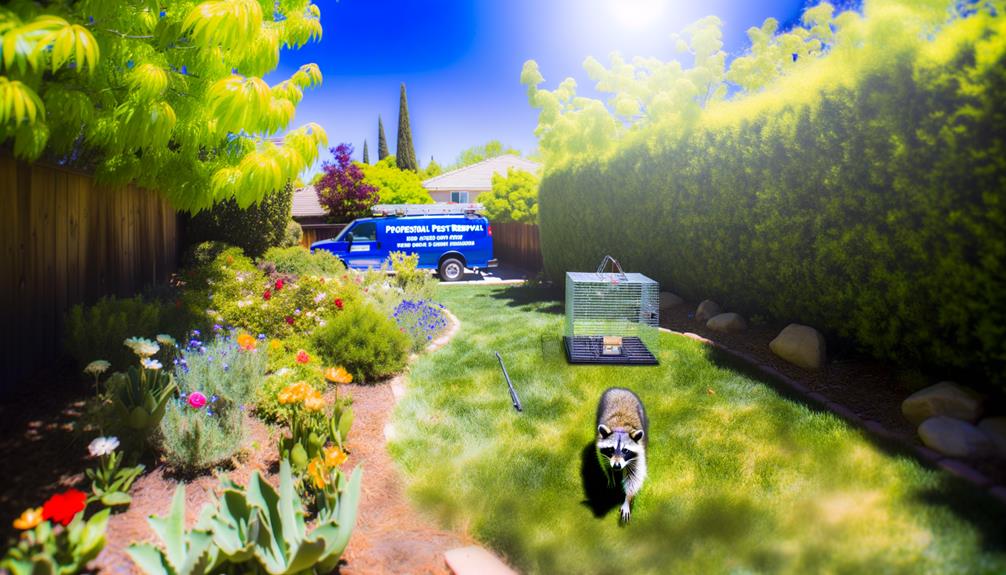Does Pest Control Kill Raccoons?
Pest control for raccoons generally focuses on humane and non-lethal methods. These include prevention through eliminating food sources, exclusion using barriers, and live trapping for safe relocation.
Regulations often prohibit indiscriminate killing, emphasizing humane treatment and compliance with legal requirements. Effective raccoon deterrents also involve physical barriers and natural repellents to create an unwelcoming environment.
Understanding raccoon behavior and habits, along with employing thorough strategies, can effectively prevent and manage infestations. For in-depth insight into these methods and their effectiveness, continue exploring.

Key Takeaways
- Pest control methods prioritize humane and non-lethal techniques for raccoons.
- Regulations often prohibit the indiscriminate killing of raccoons.
- Live trapping and relocation are commonly used humane removal methods.
- Physical barriers and repellents are preferred to deter raccoons.
- Non-lethal methods comply with legal and ethical standards.
Understanding Pest Control Methods
Effective pest control methods for raccoons involve a combination of prevention, exclusion, and humane removal techniques to ensure both the safety of the animals and the integrity of the affected property.
Prevention focuses on eliminating food sources, securing garbage bins, and sealing potential entry points.
Exclusion entails using barriers such as heavy-gauge wire mesh to block access to attics, chimneys, and crawl spaces.
Humane removal techniques include live trapping and relocation, ensuring compliance with local wildlife regulations.
These methods not only address immediate raccoon issues but also prevent future infestations.
Raccoon Behavior and Habits
Raccoons, known for their nocturnal activities and dexterous front paws, exhibit a range of behaviors and habits that are essential for understanding how to manage and control their presence on residential properties. These intelligent mammals are highly adaptable, often exploiting urban environments for easy access to food and shelter.
They typically forage at night, scavenging through garbage bins, gardens, and pet food dishes. Raccoons are also skilled climbers, using trees, fences, and even building structures to gain entry into attics or crawl spaces.
Socially, they tend to be solitary except during mating season or when mothers are rearing their young. Understanding these behaviors is vital for implementing effective pest control measures, minimizing property damage, and maintaining ecological balance.
Humane Pest Control Options
Implementing humane pest control options is essential for addressing raccoon infestations in a manner that respects animal welfare while effectively protecting property.
One effective method is the use of live traps, which capture raccoons without causing harm, allowing for their safe relocation.
Exclusion techniques, such as sealing entry points and installing chimney caps, prevent raccoons from accessing buildings.
Additionally, habitat modification, including removing food sources and securing garbage cans, deters raccoons from returning.
Non-lethal repellents, like motion-activated lights or sprinklers, can also be effective in discouraging raccoon activity.
These humane strategies not only minimize stress and injury to raccoons but also provide long-term solutions for property owners.
Legal and Ethical Considerations
When addressing raccoon infestations through humane methods, it is crucial to take into account the legal and ethical frameworks governing wildlife control. Most jurisdictions have specific regulations that prohibit the indiscriminate killing of raccoons, requiring instead that humane and non-lethal methods be employed.
Ethical considerations stress the importance of treating wildlife with respect and minimizing suffering. Additionally, professional pest control operators must often obtain permits for trapping and relocating raccoons to guarantee compliance with local laws. Penalties for non-compliance can be severe, including fines and legal action.
Hence, both ethical responsibility and legal mandates necessitate a careful, well-informed approach to managing raccoon populations, emphasizing humane treatment and adherence to regulatory guidelines.
Effective Raccoon Deterrents
To effectively deter raccoons from invading residential areas, employing a combination of physical barriers, natural repellents, and habitat modification is essential. Physical barriers, such as fencing and chimney caps, can prevent access to homes and gardens. Natural repellents like ammonia-soaked rags and predator urine can create an unwelcoming environment for raccoons. Habitat modification, such as securing trash bins and removing food sources, reduces the appeal of the area to these animals.
| Deterrent Type | Examples |
|---|---|
| Physical Barriers | Fencing, Chimney Caps |
| Natural Repellents | Ammonia-soaked Rags, Predator Urine |
| Habitat Modification | Securing Trash Bins, Removing Food Sources |
Implementing these strategies collectively provides a thorough approach to raccoon deterrence, ensuring minimal intrusion and safeguarding residential areas.
Conclusion
In sum, the exploration of pest control methods reveals a dichotomy between traditional eradication techniques and humane interventions.
Understanding raccoon behavior is paramount when devising effective deterrents.
Legal frameworks and ethical principles, echoing the sentiments of Thoreau's civil disobedience, underscore the necessity of humane treatment.
Employing non-lethal deterrents not only aligns with ethical considerations but also guarantees compliance with legal statutes, ultimately fostering a harmonious coexistence between humans and wildlife.






